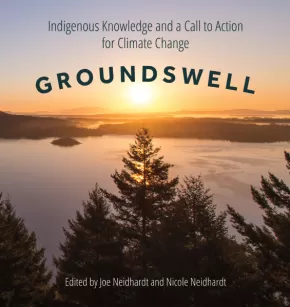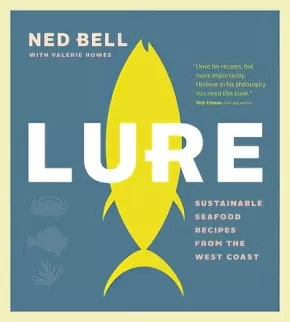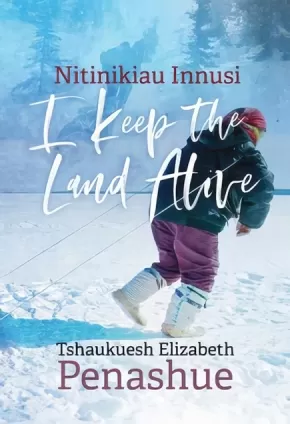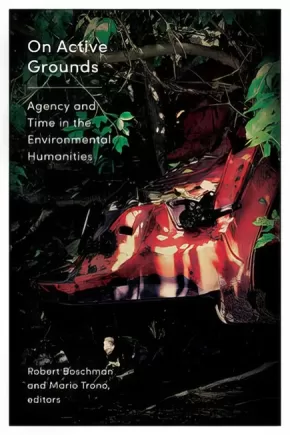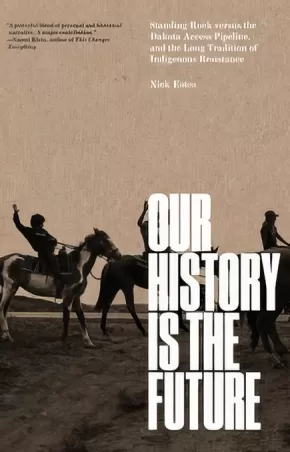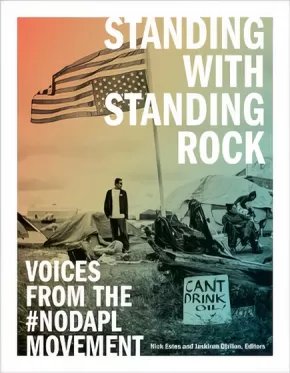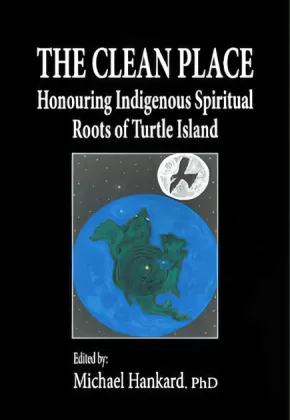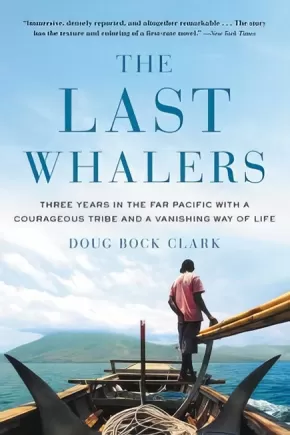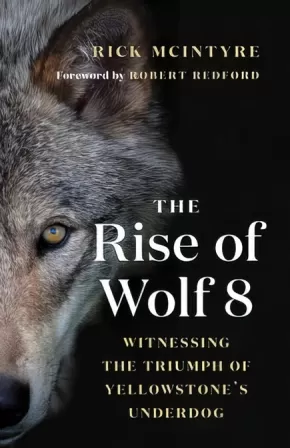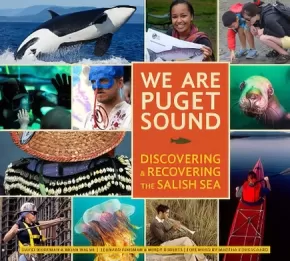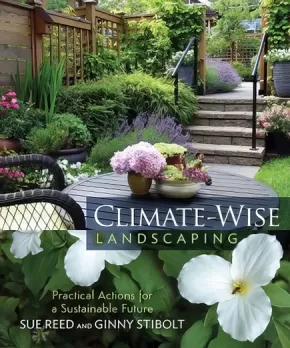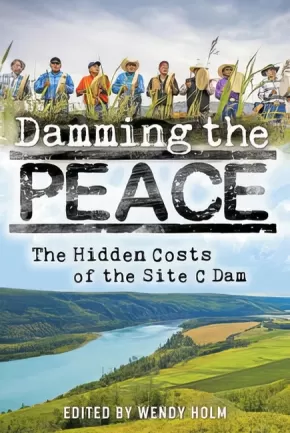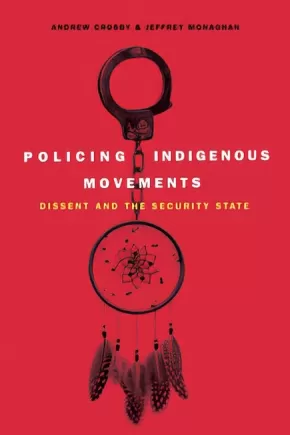
Environmental Awareness
61
-
75
of
89 Results;
Sort By
Go To
of 6
Environmental Activism on the Ground: Small Green and Indigenous Organizing
$39.99
Editors:
Format:
Paperback
Text Content Territories:
Indigenous American; Indigenous Canadian;
Grade Levels: 12; University/College;
ISBN / Barcode: 9781773850047
Synopsis:
Synopsis:
Environmental Activism on the Ground draws upon a wide range of interdisciplinary scholarship to examine small scale, local environmental activism, paying particular attention to Indigenous experiences. It illuminates the questions that are central to the ongoing evolution of the environmental movement while reappraising the history and character of late twentieth and early twenty-first environmentalism in Canada, the United States, and beyond.
This collection considers the different ways in which Indigenous and non-Indigenous activists have worked to achieve significant change. It examines attempts to resist exploitative and damaging resource developments, and the establishment of parks, heritage sites, and protected areas that recognize the indivisibility of cultural and natural resources. It pays special attention to the thriving environmentalism of the 1960s through the 1980s, an era which saw the rise of major organizations such as Greenpeace along with the flourishing of local and community-based environmental activism.
Environmental Activism on the Ground emphasizes the effects of local and Indigenous activism, offering lessons and directions from the ground up. It demonstrates that the modern environmental movement has been as much a small-scale, ordinary activity as a large-scale, elite one.
Reviews
"Environmental Activism on the Ground succeeds splendidly in complicating and enriching our understanding of modern environmentalism. Focusing on Indigenous and non-Indigenous activists in an impressive range of settings, Jonathan Clapperton and Liza Piper draw together and interpret diverse methodological and conceptual insights in a way that gives new, deserved prominence to those who have strived—and continue to strive—for environmental justice at the local level. These accounts left me both enlightened and heartened. Scholars from across the humanities and social sciences will welcome this volume." - Richard A. Rajala, Department of History, University of Victoria.
Educator Information
Table of Contents:
Illustrations
Acknowledgments
Introduction: In the Shadow of the Green Giants: Environmentalism and Civic Engagements - Jonathan Clappeton & Liza Piper
Part 1: Processes and Possibilities
1. Strategies for Survival: First Nations Encounters with Environmentalism - Anna J. Willow
2. Native/Non-Native Alliances: Challenging Fossil Fuel Industry Shipping at Pacific Northwest Ports - Zoltán Grossman
3. Conserving Contested Ground: Soverigenty-Driven Stewardship by the White Mountain Apache Tribe and the Fort Apache Heritage Foundation - Jon R. Welch
4. From Southern Alberta to Northern Brazil: Indigenous Conservation and the Preservation of Cultural Resources - Sterling Evans
5. Parks For and By the People: Acknowledging Ordinary People in the Formation, Protection, and Use of State and Provincial Parks - Jesica M. DeWitt
Part 2: Histories
6. Alternatives: Environmental and Indigenous Activism in the 1970s - Liza Piper
7. Marmion Lake Generating Station: Another Northern Scandal? - Tobasonakwut Peter Kinew
8. Environmental Activism as Anti-Conquest: The Nuu-chah-nulth and Environmentalists in the Contact Zone of Clayoquont Sound - Jonathan Clapperton
9. Local Economic Independence as Environmentalism: Nova Scotia in the 1970s - Mark Leeming
10. “Not an Easy Thing to Implement”: The Conservation Council of New Brunswick and Environmental Organization in a Resource-Dependent Province, 1969-1983 - Mark J. McLaughlin
11. The Ebb and Flow of Local Environmental Activism: The Society for Pollution and Environmental Control (SPEC), British Columbia - Jonathan Clapperton
12: From Scoieal Movement to Environmental Behemoth: How Greenpeace Got Big - Frank Zelko
Afterword: Lessons from the Ground Up - Jonathan Clapperton & Liza Piper
Bibliography
List of Contributors
Index
Additional Information
752 pages | 6.00" x 9.00"
Authenticity Note: Because this work includes contributions from Indigenous peoples, it has been labelled as containing Authentic Indigenous Text.
Groundswell: Indigenous Knowledge and a Call to Action for Climate Change
$49.95
Artists:
Editors:
Format:
Hardcover
Text Content Territories:
Indigenous;
ISBN / Barcode: 9781771743440
Synopsis:
Synopsis:
Groundswell is a collection of stirring and passionate essays from both Indigenous and non-Indigenous writers that eloquently present a compelling message about how traditional Indigenous knowledge and practices can and must be used to address climate change. The chapters interconnect, taking us from radical thinking to the gentleness of breath, and demonstrate that we are all in this together—everyone must understand what needs to be accomplished and participate in the care of Mother Earth.
Authors tap into religious and spiritual perspectives, explore the wisdom of youth, and share the insights of a nature-based philosophy. These collective writings give you a chance to contemplate and formulate your own direction. A moral revolution that can produce a groundswell of momentum toward a diverse society based on human rights, Indigenous rights, and the rights of Mother Earth.
Beautifully illustrated with photographs, Groundswell is augmented with video recordings from the authors and a short documentary film, available on the project’s website. Profits from the book will help support the videos, documentary, and future projects of The Call to Action for Climate Change. Visit www.envisionthebigpicture.com.
Reviews
"A beautifully illustrated and highly engaging read.… Essays from both Indigenous and non-Indigenous contributors present a strong vision for how traditional knowledge can be used to fight climate change, as well as how we can work together toward a more balanced and harmonious relationship with nature." – Joan Elliott, librarian and Manager of Stewart Resources Centre
“This book shares Indigenous knowledge that can teach us to listen to and be in relationship to the Earth in a way that honours the sacredness and interdependence of all life forms. A paradigm shift, informed by Indigenous ways of knowing and acting, is crucial in this time of climate change.” – Laura Stivers, author of Disrupting Homelessness: Alternative Christian Approaches
“A powerful text that introduces a much-needed perspective on the issue of climate change.… When reading the chapter ‘Rooted: Staying Grounded Amidst a Changing Landscape’ by Nicole Neidhardt, Teka Everstz, and Gina Mowatt, I was moved by the presence of youth voices. As a young, Indigenous person myself, I felt a great power, understanding, and nuance to the voices emerging in the chapter.… Nicole Neidhardt, Teka Everstz, and Gina Mowatt asked for more than a challenge of the reader’s ideology—they screamed out for a call to action." – Forrest Goodluck, award-winning youth filmmaker who appears opposite Leonardo DiCaprio in The Revenant
“The reflections of three young Indigenous activists (‘Rooted: Staying Grounded Amidst a Changing Landscape’) … are sharp, buoyant reminders of elation and advocacy in a world of overwhelming and seemingly unlimited power: colonialism, imperialism, and industrial capitalism. These narratives bring me moral conviction and faith as we all walk hand-in-hand into our carbon wrought future.” – Kalen Goodluck, freelance documentary photographer and journalist
Educator Information
Recommended Resource for Grades 11-12 and College/University Students.
Social Studies/B.C. First Peoples/Comparative Cultures/Contemporary Indigenous Studies Curricular Concepts Explored in the Text:
- Interactions between cultures and the natural environment.
- The role of value systems and belief systems in the development of cultures.
- Varied identities and worldviews of Indigenous peoples, and the importance of the interconnection of family, relationships, language, culture, and the land.
- Factors that sustain and challenge the identities and worldviews of Indigenous peoples.
Science/Environmental Science Curricular Concepts Explored in the Text:
- First Peoples knowledge and other traditional ecological knowledge in sustaining biodiversity.
- Human actions and their impact on ecosystem integrity.
- First Peoples ways of knowing and doing.
- Resource stewardship.
English/English First Peoples Curricular Concepts Explored in the Text:
- First Peoples languages and texts reflect their cultures, knowledge, histories, and worldviews.
- Critically, creatively, and reflectively explore ideas within, between, and beyond texts.
- Construct meaningful personal connections between self, text, and world.
- The diversity within and across First Peoples societies as represented in texts.
TABLE OF CONTENTS
Preface Invocation: Using Contemplative Meditation to Foster Change
Introduction: This Is the Moral Revolution
Climate Change Snapshots by Kristen Dey
Rooted: Staying Grounded Amidst a Changing Landscape by Nicole Neidhardt, Teka Everstz, and Gina Mowatt
What You Need to Know Is Not in a Book: Indigenous Education by Larry Emerson
Illuminating the Path Forward by Erin Brillon
Stories from Our Elders by Andy Everson
Religions for the Earth by Karenna Gore
How We Can Work Together by Merle Lefkoff
Essential Elements of Change by Mary Hasbah Roessel
The Radical Vision of Indigenous Resurgence by Taiaiake Alfred
Sharing the Wealth: Bending Toward Justice by Rod Dobell
The Commonwealth of Breath by David Abram
Science, Spirituality, Justice by Larry Rasmussen
The Moral Revolution, Weaving All the Parts by Joe Neidhardt
Acknowledgements
Further References
Further Readings
Contributors
Contributors: David Abram, Taiaiake Alfred, Erin Brillon, Kristen Dey, Rod Dobell, Larry Emerson, Andy Everson, Teka Everstz, Karenna Gore, Merle Lefkoff, Gina Mowatt, Joe Neidhardt, Nicole Neidhardt, Larry Rasmussen, Mary Hasbah Roessel.
Additional Information
208 Pages | 8.5" x 9" | ISBN: 9781771743440 | Hardcover
Kings of the Yukon: A River Journey in Search of the Chinook
$21.00
Format:
Paperback
Text Content Territories:
Indigenous Canadian;
Grade Levels: 12; University/College;
ISBN / Barcode: 9780345811806
Synopsis:
Synopsis:
A stunning new voice in nature writing makes an epic journey along the Yukon River to give us the stories of its people and its protagonist--the king salmon, or the Chinook--and the deepening threat to a singular way of life, in a lyrical, evocative and captivating narrative.
The Yukon River is 3,190 kilometres long, flowing northwest from British Columbia through the Yukon Territory and Alaska to the Bering Sea. Every summer, millions of salmon migrate the distance of this river to their spawning ground, where they go to breed and then die. The Chinook is the most highly prized among the five species of Pacific salmon for its large size and rich, healthy oils. It has long since formed the lifeblood of the economy and culture along the Yukon--there are few communities that have been so reliant on a single source. Now, as the region contends with the effects of a globalized economy, climate change, fishing quotas and the general drift towards urban life, the health and numbers of the Chinook are in question, as is the fate of the communities that depend on them.
Travelling in a canoe along the Yukon River with the migrating salmon, a three-month journey through untrammeled wilderness, Adam Weymouth traces the profound interconnectedness of the people and the Chinook through searing portraits of the individuals he encounters. He offers a powerful, nuanced glimpse into the erosion of indigenous culture, and into our ever-complicated relationship with the natural world. Weaving in the history of the salmon run and their mysterious life cycle, Kings of the Yukon is extraordinary adventure and nature writing and social history at its most compelling.
Awards
- 2019 Lonely Planet Adventure Travel Book of the Year Winner
- 2018 Sunday Times/Peters Fraser + Dunlop Young Writer of the Year Award
Reviews
“Travel writing? Climate change? Here’s a book that does it all . . . He writes like Annie Dillard, Bruce Chatwin and Jack London combined: suspenseful and sensitive storytelling and sumptuous descriptions.” —National Observer
“Shift over, Pierre Berton and Farley Mowat. You, too, Robert Service. Set another place at the table for Adam Weymouth, who writes as powerfully and poetically about the Far North as any of the greats who went before him.” —Roy MacGregor, author of Original Highways: Travelling the Great Rivers of Canada
“A moving, masterful portrait of a river, the people who live on its banks, and the salmon that connect their lives to the land. It is at once travelogue, natural history, and a meditation on the sort of wildness of which we are intrinsically a part. Adam Weymouth deftly illuminates the symbiosis between humans and the natural world—a relationship so ancient, complex, and mysterious that it just might save us.” —Kate Harris, author of Lands of Lost Borders: Out of Bounds on the Silk Road
“I thoroughly enjoyed traveling the length of the Yukon River with Adam Weymouth, discovering the essential connection between the salmon and the people who rely upon them. What a joy it is to be immersed in such a remote and wondrous landscape, and what a pleasure to be in the hands of such a gifted narrator.” —Nate Blakeslee, author of The Wolf: A True Story of Survival and Obsession in the West
“Beautiful, restrained, uncompromising. The narrative pulls you eagerly downstream roaring, chuckling and shimmering just like the mighty Yukon itself.” —Ben Rawlence, author of City of Thorns
“An enthralling account of a literary and scientific quest. Adam Weymouth vividly conveys the raw grandeur and deep silences of the Yukon landscape, and endows his subject, the river’s King Salmon, with a melancholy nobility.” —Luke Jennings, author of Atlantic and Codename Villanelle
“Adam Weymouth's account of his canoe trip down the Yukon River is both stirring and heartbreaking. He ably describes a world that seems alternately untouched by human beings and teetering at the brink of ruin.” —David Owen, author of Where the Water Goes
Additional Information
288 pages | 5.18" x 8.00"
Lure: Sustainable Seafood Recipes from the West Coast
$29.99
Format:
Paperback
ISBN / Barcode: 9781773270876
Synopsis:
Synopsis:
Eating sustainable seafood is about opening your mind (and fridge) to a vast array of fish and shellfish that you might not have considered before - and the Pacific Coast is blessed with an abundance of wild species. With Lure, readers embark on a wild Pacific adventure and discover the benefits of healthy oils and rich nutrients that seafood delivers. This stunning cookbook, authored by chef and seafood advocate Ned Bell, features simple techniques and straightforward sustainability guidelines around Pacific species as well as 80 delicious recipes to make at home. You'll find tacos, fish burgers, chowders, and sandwiches- the types of dishes that fill bellies, soothe souls and get happy dinner table conversation flowing on a weekday night - as well as elegant (albeit still simple-to-execute) dinner party options, such as crudo, ceviche, and caviar butter.
Reviews
“Ned’s first cookbook Lure features a set of sustainable seafood recipes that are accessible, well considered and, most importantly, delicious.” – Michael Cimarusti, Michelin-starred chef of Providence
“Ned Bell is one of that laudable cadre of young chefs who has taken the trouble to learn not only the names of his farmers but also his fishers. If, like me, you’re committed to sustaining the health of the oceans, you’ll grab this book that shows you how to cook all the responsibly-harvested gifts of the sea.” – Tom Douglas, American executive chef, restaurateur, author, and radio talk show host.
“I’m going to go out on a limb and suggest that Lure is the most important cookbook of the year, if not the decade.” – Tim Pawsey, Hired Belly
“Lure is at once a cookbook, coffee table showpiece, and educational manual. With straightforward recipes and a digestible approach to ocean sustainability, Lure is a beautiful and accessible guide for the conscientious cook.” – NUVO Magazine
“It should come as no surprise that Lure, his first cookbook, co-written with ace writer Valerie Howes, is just wonderful too. It’s a beauty of book—bright, full of gorgeous imagery and laid out in an attractive easy-to-understand style” – BC Living
Additional Information
304 pages | 9.14" x 9.99"
Nitinikiau Innusi: I Keep the Land Alive
$29.95
Format:
Paperback
Text Content Territories:
Indigenous Canadian; First Nations; Innu (Montagnais-Naskapi);
Grade Levels: University/College;
ISBN / Barcode: 9780887558405
Synopsis:
Synopsis:
Labrador Innu cultural and environmental activist Tshaukuesh Elizabeth Penashue is well-known both within and far beyond the Innu Nation. The recipient of a National Aboriginal Achievement Award and an honorary doctorate from Memorial University, she has been a subject of documentary films, books, and numerous articles. She led the Innu campaign against NATO’s low-level flying and bomb testing on Innu land during the 1980s and ’90s, and was a key respondent in a landmark legal case in which the judge held that the Innu had the “colour of right” to occupy the Canadian Forces base in Goose Bay, Labrador. Over the past twenty years she has led walks and canoe trips in nutshimit, “on the land,” to teach people about Innu culture and knowledge.
Nitinikiau Innusi: I Keep the Land Alive began as a diary written in Innu-aimun, in which Tshaukuesh recorded day-to-day experiences, court appearances, and interviews with reporters. Tshaukuesh has always had a strong sense of the importance of documenting what was happening to the Innu and their land. She also found keeping a diary therapeutic, and her writing evolved from brief notes into a detailed account of her own life and reflections on Innu land, culture, politics, and history.
Beautifully illustrated, this work contains numerous images by professional photographers and journalists as well as archival photographs and others from Tshaukuesh’s own collection.
Additional Information
288 pages | 6.00" x 8.50" | 128 colour illustrations | 1 map | bibliography
On Active Grounds: Agency and Time in the Environmental Humanities (1 in Stock) - ON SALE
$20.00 $42.99
Editors:
Format:
Paperback
Text Content Territories:
Indigenous;
Grade Levels: University/College;
ISBN / Barcode: 9781771123396
Synopsis:
Synopsis:
On Active Grounds considers the themes of agency and time through the burgeoning, interdisciplinary field of the environmental humanities. Fourteen essays and a photo album cover topics such as environmental practices and history, temporal literacy, graphic novels, ecocinema, ecomusicology, animal studies, Indigeneity, wolf reintroduction, environmental history, green conservatism, and social-ecological systems change. The book also speaks to the growing concern regarding environmental issues in the aftermath of the 2015 Paris Climate Conference (COP21) and the election of Donald Trump in the United States. This collection is organized as a written and visual appeal to issues such as time (how much is left?) and agency (who is active? what can be done? what does and does not work?). It describes problems and suggests solutions. On Active Grounds is unique in its explicit and twinned emphasis on time and agency in the context of the Environmental Humanities and a requisite interdisciplinarity.
Educator Information
Useful for these course/subject areas: Cultural Studies, Film & Media, Environmental Studies, Indigenous Studies, Environmental Humanities.
Table of Contents
Permissions
List of Figures, Photographs, and Tables
Introduction: EcocriticalAgency in Time | Mario Trono and Robert Boschman
I. Eco-Temporal Literacies
1 “The clock’s wound up”: Critical Reading Practices in the Time of Social Acceleration and Ecological Collapse | Paul Huebener
2 A Better Distribution Deal: Ecocinematic Viewing and Montagist Reply | Mario Trono
3 “Allô, ici la terre”: Agency in Ecological Music Composition, Performance, and Listening | Sabine Feisst
4 The Environmental Vampire: Terror, Time, and Territory after 9/11 | Robert Boschman
II. Timelines and Indigeneity
5 "We are key players...": Creating Indigenous Engagement and Community Control at Blackfoot Heritage Sites in Time | Geneviève Susemihl
6 Mapping a Bleak Time: The Mining Legacy of Navajo Nation | Lea Rekow
Photo Essay
Agency and Time on Active Grounds: A Memoir of Bruno Latour and Gaïa Global Circus | Robert Boschman
III. Animal Agents and Human-NonhumanInteractions
7 The Gaze of Predators, Fleshly Worlds, and the Redefinition of the Human | Karla Armbruster
8 Anim-oils: Wild Animals in Petro-Cultural Landscapes | Pamela Banting
9 Reacting to Wolves: The Historical Construction of Identity and Value | Morgan Zedalis and Sean Gould
IV. Systems Change in Time
10 Declarations of Interdependence: Unexpected Human-Animal Conflict and Bhutanese Nonlinear Policy | Randy Schroeder and Kent Schroeder
11 Future Environmental Action in Canada: The German Energiewende as a Model of Public Agency | Mishka Lysack
12 Culture as Vector: (Re)Locating Agency in Social-Ecological Systems Change | Nancy Doubleday
Additional Information
296 pages | 6.00" x 9.00"
Text Content Note: Includes some Indigenous content.
Our History Is the Future: Standing Rock Versus the Dakota Access Pipeline, and the Long Tradition of Indigenous Resistance
$35.95
Format:
Hardcover
Text Content Territories:
Indigenous American; Native American; Sioux; Dakota; Lakota;
Grade Levels: 12; University/College;
ISBN / Barcode: 9781786636720
Synopsis:
Synopsis:
How two centuries of Indigenous resistance created the movement proclaiming “Water is life”.
In 2016, a small protest encampment at the Standing Rock Reservation in North Dakota, initially established to block construction of the Dakota Access oil pipeline, grew to be the largest Indigenous protest movement in the twenty-first century. Water Protectors knew this battle for native sovereignty had already been fought many times before, and that, even after the encampment was gone, their anticolonial struggle would continue. In Our History Is the Future, Nick Estes traces traditions of Indigenous resistance that led to the #NoDAPL movement. Our History Is the Future is at once a work of history, a manifesto, and an intergenerational story of resistance.
Reviews
“Embedded in the centuries-long struggle for Indigenous liberation resides our best hope for a safe and just future for everyone on this planet. Few events embody that truth as clearly as the resistance at Standing Rock, and the many deep currents that converged there. In this powerful blend of personal and historical narrative, Nick Estes skillfully weaves together transformative stories of resistance from these front lines, never losing sight of their enormous stakes. A major contribution.”—Naomi Klein, author of This Changes Everything
“In Our History Is the Future historian Nick Estes tells a spellbinding story of the 10 month Indigenous resistance at Standing Rock in 2016, animating the lives and characters of the leaders and organizers, emphasizing the powerful leadership of the women. Alone this would be a brilliant analysis of one of the most significant social movements of this century. But embedded in the story and inseparable from it is the centuries-long history of the Oceti Sakowin’ resistance to United States’ genocidal wars and colonial institutions. And woven into these entwined stories of Indigenous resistance is the true history of the United States as a colonialist state and a global history of European colonialism. This book is a jewel—history and analysis that reads like the best poetry—certain to be a classic work as well as a study guide for continued and accelerated resistance.”—Roxanne Dunbar Ortiz, author of An Indigenous Peoples’ History of the United States
“When state violence against peaceful protest at Standing Rock became part of the national consciousness, many noticed Native people for the first time—again. Our History Is the Future is necessary reading, documenting how Native resistance is met with settler erasure: an outcome shaped by land, resources, and the juggernaut of capitalism. Estes has written a powerful history of Seven Fires resolve that demonstrates how Standing Rock is the outcome of history and the beginning of the future.”—Louise Erdrich, author of the National Book Award winner The Round House
“A touching and necessary manifesto and history featuring firsthand accounts of the recent Indigenous uprising against powerful oil companies … With an urgent voice, Estes reminds us that the greed of private corporations must never be allowed to endanger the health of the majority. An important read about Indigenous protesters fighting to protect their ancestral land and uphold their historic values of clean land and water for all humans.” —Kirkus
“Our History Is the Future is a game-changer. In addition to providing a thorough and cogent history of the long tradition of Indigenous resistance, it is also a personal memoir and homage to the Oceti Sakowin; an entreaty to all their relations that demands the ‘emancipation of the earth.’ Estes continues in the legacy of his ancestors, from Black Elk to Vine Deloria, he turns Indigenous history right-side up as a story of self-defense against settler invasion. In so doing, he is careful and judicious in his telling, working seamlessly across eras, movements, and scholarly literatures, to forge a collective vision for liberation that takes prophecy and revolutionary theory seriously. The book will be an instant classic and go-to text for students and educators working to understand the ‘structure’ undergirding the ‘event’ of the Dakota Access Pipeline. This is what history as Ghost Dance looks like.”—Sandy Grande, author of Red Pedagogy: Native American Social and Political Thought
“Nick Estes is a forceful writer whose work reflects the defiant spirit of the #NoDAPL movement. Our History Is the Future braids together strands of history, theory, manifesto and memoir into a unique and compelling whole that will provoke activists, scholars and readers alike to think deeper, consider broader possibilities and mobilize for action on stolen land.”—Julian Brave Noisecat, 350.org
Additional Information
320 pages | 5.50" x 8.25"
Standing with Standing Rock: Voices from the #NoDAPL Movement (3 in Stock) - ON SALE
$26.96 $35.95
Editors:
Format:
Paperback
Text Content Territories:
Indigenous American;
Grade Levels: 12; University/College;
ISBN / Barcode: 9781517905361
Synopsis:
Synopsis:
Dispatches of radical political engagement from people taking a stand against the Dakota Access Pipeline.
It is prophecy. A Black Snake will spread itself across the land, bringing destruction while uniting Indigenous nations. The Dakota Access Pipeline is the Black Snake, crossing the Missouri River north of the Standing Rock Indian Reservation. The oil pipeline united communities along its path—from North Dakota, South Dakota, Iowa, and Illinois—and galvanized a twenty-first-century Indigenous resistance movement marching under the banner Mni Wiconi—Water Is Life! Standing Rock youth issued a call, and millions around the world and thousands of Water Protectors from more than three hundred Native nations answered. Amid the movement to protect the land and the water that millions depend on for life, the Oceti Sakowin (the Dakota, Nakota, and Lakota people) reunited. A nation was reborn with renewed power to protect the environment and support Indigenous grassroots education and organizing. This book assembles the multitude of voices of writers, thinkers, artists, and activists from that movement.
Through poetry and prose, essays, photography, interviews, and polemical interventions, the contributors, including leaders of the Standing Rock movement, reflect on Indigenous history and politics and on the movement’s significance. Their work challenges our understanding of colonial history not simply as “lessons learned” but as essential guideposts for current and future activism.
Contributors: Dave Archambault II, Natalie Avalos, Vanessa Bowen, Alleen Brown, Kevin Bruyneel, Tomoki Mari Birkett, Troy Cochrane, Michelle L. Cook, Deborah Cowen, Andrew Curley, Martin Danyluk, Jaskiran Dhillon, Roxanne Dunbar-Ortiz, Liz Ellis, Nick Estes, Marcella Gilbert, Sandy Grande, Craig Howe, Elise Hunchuck, Michelle Latimer, Layli Long Soldier, David Uahikeaikalei‘ohu Maile, Jason Mancini, Sarah Sunshine Manning, Katie Mazer, Teresa Montoya, Chris Newell, The NYC Stands with Standing Rock Collective, Jeffrey Ostler, Will Parrish, Shiri Pasternak, endawnis Spears, Alice Speri, Anne Spice, Kim TallBear, Mark L. Tilsen, Edward Valandra, Joel Waters, Tyler Young.
Reviews
"As our songs and prayers echo across the prairie, we need the public to see that in standing up for our rights, we do so on behalf of the millions of Americans who will be affected by this pipeline."—David Archambault II, from the interior
"There is no alternative to water. There is no alternative to this Earth. This fight has become my life, and it’s not over. I think this is only the beginning for me, for all of us. Do you want a future for your children and grandchildren? If you want them to have a future then stand with Standing Rock because this is just the beginning of a revolution."—Zaysha Grinnell, from the interior
"We will put our best warriors in the front. We are the vanguard. We are the Hunkpapa Lakota. That means the horn of the buffalo. That’s who we are. We are protectors of our nation of Oceti Sakowin, the Seven Council Fires. Know who we are."—Phyllis Young
Additional Information
448 pages | 7.00" x 9.00"
The Clean Place: Honouring Indigenous Spiritual Roots of Turtle Island (1 in Stock)
$33.00
Editors:
Format:
Paperback
Text Content Territories:
Indigenous American; Indigenous Canadian;
Grade Levels: 12; University/College;
ISBN / Barcode: 9781926476261
Synopsis:
Synopsis:
Within Turtle Island Indigenous people know that its spiritual centre is the ultimate mover within everything we do and are surrounded by. The Clean Place: Honouring Indigenous Spiritual Roots of Turtle Island illuminates the strong connection Indigenous people have with the land and the importance of a paradigm shift worldwide toward sustainable ways of thinking and being. The voices and perspectives of the writers weave traditional teachings, spirituality, and messages of hope, change, and transformation.
Reviews
"Hankard’s compilation takes us on a journey throughout Turtle Island and beyond, across sacred oceans to the ancestral homelands of our relatives. This journey illuminates a connecting theme of Indigenous existence on, from and with the land as a sacred being. Upon a shared reading of a chapter with my son, it was clear he embodied the teachings within – he was doing his part in maintaining the Clean Place." - Cindy Peltier, PhD, Chair Indigenous Education Nipissing University
Educator Information
Table of Contents
Dedication
Acknowledgement
Gchi-Biimskogaabiwiding
Introduction
Michael Hankard
1. I Still Have the Place
Lorraine Rekmans
2. Unsettling the Clean Place: Beginnings of a Philosophical Reflection
Réal Fillion
3. Giving Thanks for the Light
Ross Hoffman
4. In Place and Time: Indigenous Women’s Re-Weaving and Resistances
Laura Hall
5. The Healing Journey: Spirituality, Cultural Connection and the Significance of Aboriginal Peoples Relationship to the Land
John E. Charlton & John G. Hansen
6. Honouring Papatuanuku: Honouring Mother Earth
Taima Moeke-Pickering
7. Stewards of the Sacred
Cynthia Landrum
8. A Buffalo’s Breath on a Cold Winter Morning
Michael Hankard
9. Wahi Pana: A Hawaiian Sense of Place and Relationship to the Land
Umi Perkins
10. The Land is One with Us, and We are One with the Land: A Personal Journal
Emily Faries
11. Caring for Past/Present/Future Through Anishinabe Photography on the Land
Celeste Pedri-Spade
12. Washed ‘Clean’ in Zimbabwe: The Dzivaguru Creation Story
Collis G. Machoko
13. Reflections on Urban Connections to Land and Ceremony: Uncovering the Virtues of Creativity, Cultural Resiliency, Flexibility and Tenacity
Barbara Waterfall
14. Biinidsa: Going Home to Clean Up
Kevin FitzMaurice
Epilogue: Clean Water in the ‘Clean Place’?
Maurice Switzer
About the Authors
Additional Information
251 pages | 6.00" x 9.00"
The Last Whalers: Three Years in the Far Pacific with a Courageous Tribe and a Vanishing Way of Life
$23.99
Format:
Paperback
Text Content Territories:
Indigenous Peoples in Indonesia; Lamaleran;
ISBN / Barcode: 9780316390613
Synopsis:
Synopsis:
In this "immersive, densely reported, and altogether remarkable first book [with] the texture and color of a first-rate novel" (New York Times), journalist Doug Bock Clark tells the epic story of the world's last subsistence whalers and the threats posed to a tribe on the brink.
On a volcanic island in the Savu Sea so remote that other Indonesians call it "The Land Left Behind" live the Lamalerans: a tribe of 1,500 hunter-gatherers who are the world's last subsistence whalers. They have survived for half a millennium by hunting whales with bamboo harpoons and handmade wooden boats powered by sails of woven palm fronds. But now, under assault from the rapacious forces of the modern era and a global economy, their way of life teeters on the brink of collapse.
Award-winning journalist Doug Bock Clark, one of a handful of Westerners who speak the Lamaleran language, lived with the tribe across three years, and he brings their world and their people to vivid life in this gripping story of a vanishing culture. Jon, an orphaned apprentice whaler, toils to earn his harpoon and provide for his ailing grandparents, while Ika, his indomitable younger sister, is eager to forge a life unconstrained by tradition, and to realize a star-crossed love. Frans, an aging shaman, tries to unite the tribe in order to undo a deadly curse. And Ignatius, a legendary harpooner entering retirement, labors to hand down the Ways of the Ancestors to his son, Ben, who would secretly rather become a DJ in the distant tourist mecca of Bali.
Deeply empathetic and richly reported, The Last Whalers is a riveting, powerful chronicle of the collision between one of the planet's dwindling indigenous peoples and the irresistible enticements and upheavals of a rapidly transforming world.
Additional Information
368 pages
The Rise of Wolf 8
$34.95
Format:
Hardcover
ISBN / Barcode: 9781771645218
Synopsis:
Synopsis:
The astonishing true story of one of the first wolves to roam Yellowstone in more than 60 years.
Yellowstone National Park was once home to an abundance of wild wolves—but park rangers killed the last of their kind in the 1920s. Decades later, the rangers brought them back, with the first wolves arriving from Canada in 1995.
This is the incredible true story of one of those wolves.
Wolf 8 struggles at first—he is smaller than the other pups, and often bullied—but soon he bonds with an alpha female whose mate was shot. An unusually young alpha male, barely a teenager in human years, Wolf 8 rises to the occasion, hunting skillfully, and even defending his family from the wolf who killed his father. But soon he faces a new opponent: his adopted son, who mates with a violent alpha female. Can Wolf 8 protect his valley without harming his protégé?
Authored by a renowned wolf researcher and gifted storyteller, The Rise of Wolf 8 marks the beginning of an original and bold new trilogy, which will transform our view of wolves forever.
Reviews
"Rick’s book is a testament to the irreplaceable value of direct and long term observation of wild animals in their habitat. No trick of modern technology will ever be able to catch the subtleties of the messages sent by just a glance or the sophisticated mechanisms of leadership in a wolf pack. This book will tell you all this and much more: its contribution to wolf biology is immense, for scientists as well as for wolf lovers." —Luigi Boitani, Honorary Professor, Department of Biology and Biotechnologies, University of Rome, Italy
"McIntyre has here written the captivating story of individual wolves and their personalities in their natural setting of competing with other packs, starting with those reintroduced into Yellowstone Park. Their stories will become a classic in animal behavior, with impacts reaching into ecology, conservation biology, and comparisons to human social evolution. All is presented with skill and verve to be accessible to a wide audience."—Bernd Heinrich, PhD, professor emeritus of biology at the University of Vermont and author of Mind of the Raven
Educator Information
Book One in The Alpha Wolves of Yellowstone: A Trilogy.
Additional Information
304 pages | 5.50" x 8.50"
We Are Puget Sound: Reclaiming a Wilder Salish Sea
$41.95
Format:
Hardcover
Text Content Territories:
Indigenous Canadian; First Nations; Indigenous American; Native American;
ISBN / Barcode: 9781680512588
Synopsis:
Synopsis:
Puget Sound is a magnificent and intricate estuary, the very core of life in Western Washington. Yet it’s also a place of broader significance: rivers rush from the Cascade and Olympic mountains and Canada’s coastal ranges through varied watersheds to feed the Sound, which forms the southern portion of a complex, international ecosystem known as the Salish Sea.
A rich, life-sustaining home shared by two countries, as well as 50-plus Native American Tribes and First Nations, the Salish Sea is also a huge economic engine, with outdoor recreation and commercial shellfish harvesting alone worth $10.2 billion. But this spectacular inland sea is suffering. Pollution and habitat loss, human population growth, ocean acidification, climate change, and toxins from wastewater and storm runoff present formidable challenges.
We Are Puget Sound amplifies the voices and ideas behind saving Puget Sound, and it will help engage and inspire citizens around the region to join together to preserve its ecosystem and the livelihoods that depend on it.
Additional Information
224 pages | 10.00" x 9.00" | 125 colour photographs
Climate-Wise Landscaping: Practical Actions for a Sustainable Future
$29.99
Format:
Paperback
ISBN / Barcode: 9780865718883
Synopsis:
Synopsis:
What can we do, right now, in our own landscapes, to help solve climate change?
Predictions about future effects of climate change range from mild to dire - but we're already seeing warmer winters, hotter summers, and more extreme storms. Proposed solutions often seem expensive and complex, and can leave us as individuals at a loss, wondering what, if anything, can be done.
Sue Reed and Ginny Stibolt offer a rallying cry in response - instead of wringing our hands, let's roll up our sleeves. Based on decades of experience, this book is packed with simple, practical steps anyone can take to beautify any landscape or garden, while helping protect the planet and the species that call it home. Topics include:
- Working actively to shrink our carbon footprint through mindful landscaping and gardening
- Creating cleaner air and water
- Increasing physical comfort during hotter seasons
- Supporting birds, butterflies, pollinators, and other wildlife.
This book is the ideal tool for homeowners, gardeners, and landscape professionals who want to be part of the solution to climate change.
Reviews
"Sue Reed and Ginny Stibolt bring complementary backgrounds to bear on the subject of how we can adapt our landscapes to a changing climate. Starting from the premise that the impacts of climate change will only become more severe in the future, the authors have created a comprehensive book that outlines dozens of actions that people can take to adjust to evolving climate regimes. In the process, they articulate a new gardening aesthetic for people who work with small garden plots, farms and woodlots. The result is a positive and hopeful story of how people can use their imagination and ingenuity to help craft more resilient landscapes." -Dr. Peter Robinson, former CEO, David Suzuki Foundation
"Climate-Wise Landscaping is a comprehensive, yet easy to read, source of information on climate-change adaptation and mitigation actions for the homeowner, gardener, and landscape professional. Beautiful photos and pleasing graphics illustrate key ideas and actions while informative sidebars and inspiring quotes from climate and landscape experts provide clarity of complex systems and motivation to adapt to a changing future. The text provides an engaging blend of broad ideas along with specific actions we can take to adapt to climate-change at the level of our home landscapes, whether a small garden plot within an urban area or twenty acres in the countryside." -Julie Richburg, Ph.D., Ecologist
"Given the lateness of the hour, a book on climate-wise landscaping could not be more timely or more necessary. We are moving into a new and critical era, and this book takes landscape professionals and home gardeners where they need to go. The facts, well-presented and practical, will be an eye-opener for many people, and empower us as horticulturists of all stripes to do what is both helpful and imperative. Landscaping has always been more than just exterior decorating, and now we have one more tool in our kit to make the landscape ecosystem a part of the solution. Thank you, Sue and Ginny, for hitting a home run." -Owen Dell RLA, ASLA, landscape architect, educator, author, Owen Dell & Associates
"Gardening is not always as green and good for the planet as we might think. Sue Reed and Ginny Stibolt open our eyes to surprisingly common, unsustainable landscaping practices and inspire us to rethink how we create and care for land. This fantastic resource is filled with climate-wise solutions for anyone who owns or manages a piece of ground – even if it’s just a few containers on a tiny rooftop garden. You will quickly learn about exiting ways to offset some of the effects we people have on the planet. The book is easy to navigate and it passionately links better gardening practices with better life quality and a brighter future for our planet." -Claudia West ASLA, Principal, PHYTO STUDIO LLC
Additional Information
320 pages | 7.50" x 9.00" | full colour throughout
Damming the Peace: The Hidden Costs of the Site C Dam
$22.95
Editors:
Format:
Paperback
Text Content Territories:
Indigenous Canadian; First Nations;
ISBN / Barcode: 9781459413160
Synopsis:
Synopsis:
Since the 1970s, the Site C Dam in northeastern British Columbia's Peace River Valley has been touted by B.C. Hydro and successive governments as necessary to meet the province's increasing energy needs. With its enormous $10 billion price tag, the dam would be the largest public works project in BC history. It would be the third dam on the Peace River, and destroy traditional unceded territory belonging to Treaty 8 First Nations.
Following the last provincial election, the newly appointed NDP government called for a review of the project, but work on the dam continues. This comes after protests by aboriginal groups and landowners, several lawsuits against the government, and federal government intervention to let the dam go ahead. More recently, there has been a call from a United Nations panel to review how the dam will affect Indigenous land.
This book presents the independent voices of citizen experts describing every important impact of the dam, including:
- Sustainable energy expert Guy Dauncey on future energy demand, and whether there is likely to be a need for the dam's electricity
- An interview with aboriginal activist Helen Knott on the dam's assault on traditional lands and culture, in particular Indigenous women
- Agrologist Wendy Holm on the farm land impact — prime horticulture land important to food security and nutrition
- Family physician Warren Bell on the effect that loss of traditional way of life and connection to the land has had on the health of aboriginal people
- Wildlife biologist Brian Churchill with forty years' experience of studying its land and wildlife
- Former environmental minister Joan Sawicki on government cover-ups and smoking guns
- Energy industry watchdog Andrew Nikiforuk on the links between dams, fracking and earthquakes
- Award-winning broadcaster Rafe Mair on how party politics corrupts political leadership, and the role of activism and civil disobedience in shaping government decision-making
- David Schindler, one of the world's foremost water ecologists, explains the role dams like Site C will play in Canada's climate change strategy
- Joyce Nelson connects the dots between the Site C dam and continental water sharing plans
Reviews
"Wendy Holm brings another perspective to the case against Site C, that of the production of crops." — Nelson Star, January 2018
"A massive, $10 billion hydroelectric dam project on British Columbia’s Peace River could threaten the First Nations peoples who live nearby. This volume dives deep into the potential impacts and decades of governmental cover-ups related to this long-planned project."— John R. Platt, The Revelator, April 2018
"This book provides an organized and rigorous “how to” guide on the intellectual and fact-based opposition to Site C, and in doing this becomes a great model for a book on any long-term protest. Its ambition is to inform on the subject from every possible angle, keeping the Peace River, the region and its people in mind, rather than the expediency of the business and government angle, which is usually given at least equal weight by the mainstream media." — Cathryn Atkinson, Rabble, June 2018
"There is an "elephant in the room" — not the huge white elephant that you see at No-Site C rallies. This elephant is dark and invisible. The government does not talk about it ... No. This elephant is rather more sinister. Wendy Holm confronts it and exposes it. It's about exporting water."— John Gellard, The Ormsby Review, August 2018
"Damming the Peace is an accessible, thoughtful and informative collection of essays that reveal the grave environmental, human and economic costs if the Site C dam is built."— Tim Pelzer, People's Voice, October 2018
Educator Information
Includes Indigenous content/perspectives and an Interview with Indigenous activist Helen Knott.
Additional Information
272 pages | 6.00" x 9.00"
Policing Indigenous Movements
$25.00
Format:
Paperback
Text Content Territories:
Indigenous Canadian;
Grade Levels: University/College;
ISBN / Barcode: 9781773630120
Synopsis:
Synopsis:
In recent years, Indigenous peoples have lead a number of high profile movements fighting for social and environmental justice in Canada. From land struggles to struggles against resource extraction, pipeline development and fracking, land and water defenders have created a national discussion about these issues and successfully slowed the rate of resource extraction.
But their success has also meant an increase in the surveillance and policing of Indigenous peoples and their movements. In Policing Indigenous Movements, Crosby and Monaghan use the Access to Information Act to interrogate how policing and other security agencies have been monitoring, cataloguing and working to silence Indigenous land defenders and other opponents of extractive capitalism. Through an examination of four prominent movements — the long-standing conflict involving the Algonquins of Barriere Lake, the struggle against the Northern Gateway Pipeline, the Idle No More movement and the anti-fracking protests surrounding the Elsipogtog First Nation — this important book raises critical questions regarding the expansion of the security apparatus, the normalization of police surveillance targeting social movements, the relationship between police and energy corporations, the criminalization of dissent and threats to civil liberties and collective action in an era of extractive capitalism and hyper surveillance.
In one of the most comprehensive accounts of contemporary government surveillance, the authors vividly demonstrate that it is the norms of settler colonialism that allow these movements to be classified as national security threats and the growing network of policing, governmental, and private agencies that comprise what they call the security state.
Reviews
“An accessible must-read for all Canadians concerned about respectful relations with indigenous people and the decline of civil rights in the war-on-terror era.” — Publishers Weekly
Additional Information
192 pages | 6.00" x 9.00"
Sort By
Go To
of 6




